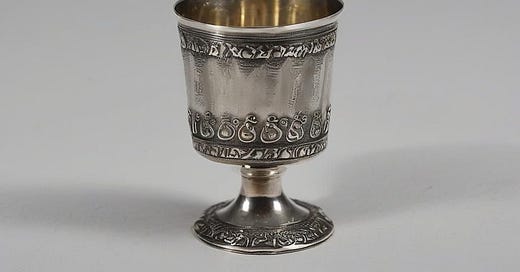This essay is part of a new collection of work inspired by the anthology On Being Jewish Now: Reflections of Authors and Advocates. Want to contribute? Instructions here. Subscribe here.
After my mother passed away, my two brothers and I began the project of dismantling the family home. We donated or sold most of the contents, which had accumulated over 65 years, and divided what remained. I walked away with most of the Judaica.
The centuries-old oil painting of an Orthodox Jew had been a wedding gift to my great-grandparents, and he hung on our living room wall my whole life. His beard and sidelocks were gray. He wore a dark shtreimel on his head and a tallit on his shoulders. His left hand rested on an open page of a holy book, and his dark eyes stared at his viewers.
Before he took his place in our living room, he hung in my mother’s childhood home in Switzerland, and before that, in her grandparents’ home in Poland. The paint is crumbling, the original frame cracking. I don’t know the name of the artist or the name of the subject, but I know that the man’s wise eyes have watched over generations of my family.
Heavy-bound religious books with cracked spines and missing pages now sit proudly on my family room bookshelf. The pages barely hold together in their binding, but the words—read and studied by my ancestors—carry through the centuries. Talmudic tractates, siddurim and machzorim that were prayed from three times a day or on the holiest days of the Jewish year. Books hailing from turn-of-the-twentieth-century-or-earlier Polish and German Jewish publishers, in Hebrew/Polish or in Hebrew/German. “Read in the language of your choice,” we are told. And our family did—and does.
The heirloom silver now lives on shelves in our dining room cabinet: a pair of intricate candlesticks that heralded in the weekly Shabbat Queen and every Jewish holiday; and a double-sided salt cellar with a miniature serving spoon for salting our daily bread and weekly challah after they were blessed. A bottle stopper for the kiddush wine. And the small etched kiddush cups—engraved with images of shtetl rooftops—that crossed oceans and centuries.
Before Jewish holidays, I gently polish these silver artifacts—up and down, round and round—and imagine the tables they sat on before they reached mine. I try to picture Shabbat or Jewish holidays as they were celebrated by my ancestors. I imagine the holiness of the day, the laughter that was heard and the tears that perhaps were shed around the family table. I feel a strong bond with the grandparents, great-grandparents, aunts, uncles and cousins I never knew, but who also observed Jewish traditions.
Family heirlooms like these bring out my pride as a Jew. These are not heirlooms that sit on shelves behind glass doors; they are taken out and used with great love and care. The religious books and silver pieces allow me to practice Jewish traditions that have been passed down through the ages – not only in my family, but in the world at large. Every time I look up at that portrait of the Orthodox Jew, I think about how much he’s seen in his lifetime. He is an observer—and a reminder of my family history.
My family has crossed borders and countries, languages and oceans, but our practice of Judaism has remained steadfast. These Jewish books and Judaica have traveled with them, and I am honored to be their current keeper.
Pearl Adler Saban lives in Toronto, Canada. She is an avid reader, and works as a freelance editor and copy editor. When not reading or editing, she writes and publishes poetry, personal essays, and book reviews.
This essay is part of a new collection of work inspired by the anthology On Being Jewish Now: Reflections of Authors and Advocates. Want to contribute? Instructions here. Subscribe here.





